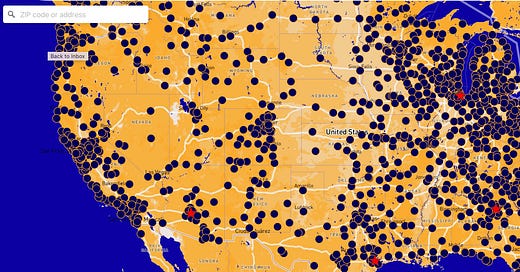No Kings Day: Check Out this Interactive Map of Protest Locations
Opponents of autocracy are rallying in nearly 2,000 cities and towns this Saturday, June 14
“Constitutions Over Kings” is the sign I’m carrying this Saturday in Nashville
Let’s face it. If you and I don’t stand up for our democracy, who will?
Protests aren’t just for so-called “activists.”
They’re for you and me—for our democracy, our rights, our sanity.
Protests are the lifeblood of democracy.
No Kings—a brilliant movement name, by the way—has already organized protests in nearly 2,000 locations across the country.
Have a look at this interactive map. It’s a beautiful sight to see.
Notice in the top left corner a small text box where you can put in your zip code to find a protest near you.
No Kings Day, Saturday, June 14
Step 1: Click the button below
Step 2: Enter your zip code in the text box in the top left corner
Step 3: Voilà, now you know where to go—and when
Step 4: Share this post
But I’m afraid. Should I go? Should I bring my children?
Yes—you should go. And yes—you should bring your children.
Don’t leave this vital work to someone else. Go with friends, family, neighbors, colleagues—and especially with your children.
We have to show up, because democracies die in fear.
*******
Eli Merritt is a political historian at Vanderbilt University and the author Disunion Among Ourselves: The Perilous Politics of the American Revolution
Public Lectures
The Enduring Principles of Declaration of Independence
America’s 250th Anniversary: Forging Unity Through History
Why Democrats Should Reclaim the American Founding
How to Talk About the 'Fourth of July'







https://substack.com/@mlk1108030/note/c-103290975?r=129s77&utm_medium=ios&utm_source=notes-share-action
*Please Share*
Sitting down makes you physically vulnerable, reducing your ability to flee or protect yourself if violence escalates.
Tear gas is more concentrated near the ground, exposing seated protesters to more intense effects like choking, burning eyes, and disorientation.
This strategy may unintentionally endanger people with disabilities who may not be able to sit down or get back up quickly, or who might need mobility aids, putting them at greater risk in a chaotic environment.
Aggressors or law enforcement may not respect peaceful actions, and remaining passive does not guarantee safety, force may still be used indiscriminately.
It relies on full crowd coordination, but not everyone will understand or be able to follow the sit-down signal in a high-stress moment, which can lead to confusion, panic, or even stampedes.
It can create a false sense of security, giving violent actors a strategic advantage while peaceful protesters are immobilized and more easily targeted.